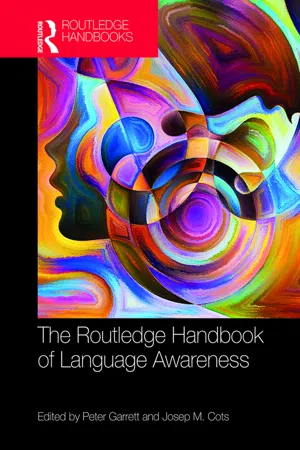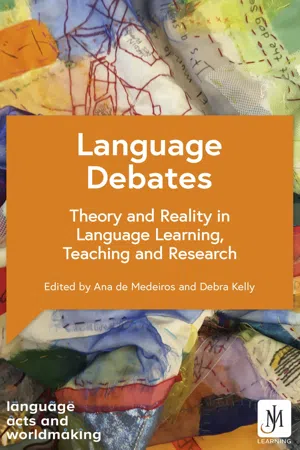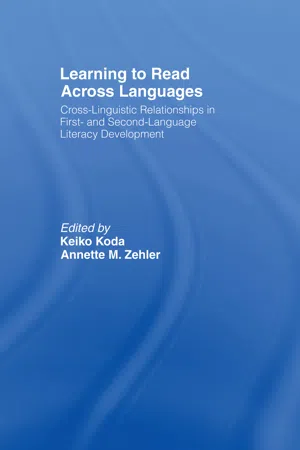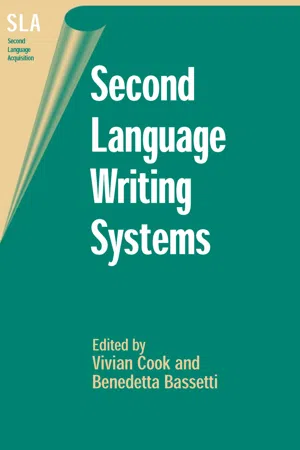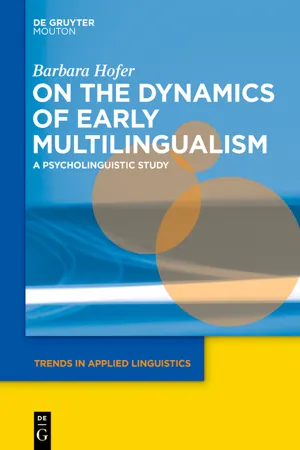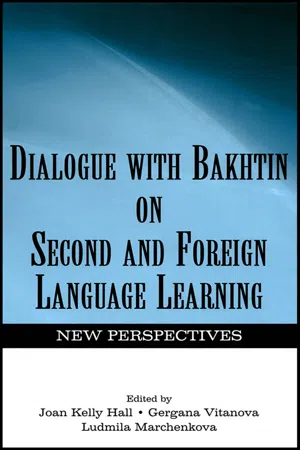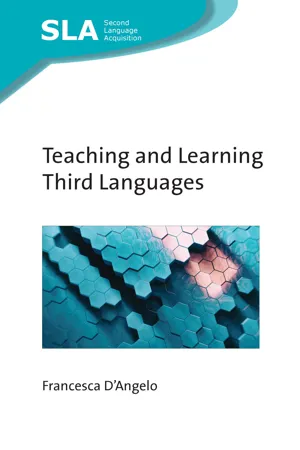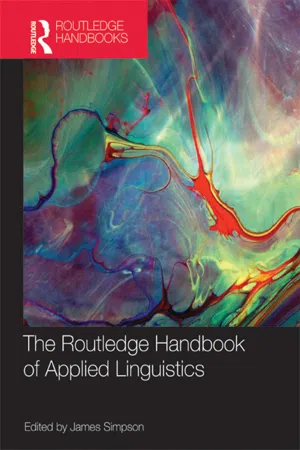Languages & Linguistics
Metalinguistics
Metalinguistics refers to the study of language itself, including its structure, usage, and meaning. It involves analyzing and discussing language as a system, as well as examining how language is used to talk about language. This field of study is concerned with understanding the nature and functions of language, as well as how it is used and interpreted by speakers and listeners.
Written by Perlego with AI-assistance
Related key terms
Related key terms
1 of 4
Related key terms
1 of 3
9 Key excerpts on "Metalinguistics"
- eBook - ePub
- Peter Garrett, Josep M. Cots(Authors)
- 2017(Publication Date)
- Routledge(Publisher)
linguistics and cognitive psychology) (Gombert, 1996). For linguists, it refers to the uses of language to talk about language (Gombert, 1996: 41). This perspective was originally expressed by Jakobson (1960), who discussed the metalingual function of language as those instances in which speakers focus on language itself in order to verify whether they use the same code. Likewise, Rey-Debove (1978) notes that: “It is generally accepted that language has a ‘metalinguistic function’, in other words, that language is sometimes used for talking about language” 1 (p. 1). This natural self-referential property of language is what Lyons (1995) calls ‘reflexivity’. From this perspective, linguists have been mainly interested in studying the formal characteristics of language that are specific to this metalinguistic function. For cognitive psychologists, on the other hand, metalinguistic activities correspond to a subfield of metacognition that is concerned with language and its use (Gombert, 1992: 13; Gombert, 1996: 41), and encompasses any reflection about language as well as conscious control and intentional planning activities that individuals experience (e.g. consciously adding an affix to a word to create another one, as in ‘house’ and ‘housing’). As will be seen in the following presentation, both these conceptions are found in the various definitions of the metalinguistic constructs 2 investigated in SLA research. Metalinguistic Knowledge Metalinguistic knowledge is one of the most common metalinguistic constructs examined in SLA and is typically equated with explicit knowledge of language. For instance, Alderson, Clapham and Steel (1997) simply define it as “knowledge about language” (p. 95) and Hu (2002) as “explicit and verbalizable knowledge about L2 grammar” (p. 348) - eBook - ePub
Language Debates
Theory and Reality in Language Learning, Teaching and Research
- Various(Author)
- 2021(Publication Date)
- John Murray Languages(Publisher)
lo can be considered to be; how these various usages (and others) are related in meaning, and how these meanings are rendered in other languages.Conclusion
I hope to have demonstrated that linguistics has an essential role to play in facilitating language teaching and in enhancing learning. I am not suggesting reversion to the old, classically inspired, ways of language teaching which were based on the rote learning of morphological paradigms and grammar drills based on specially devised material; but what I am suggesting is that grammatical structure should be revealed more explicitly in teaching and that learners should be encouraged to take an active interest in it themselves. I also see a distinctive application for the study of linguistics within a Modern Languages curriculum, and believe that engagement with linguistic questions should be a part of every academic linguist’s training.Passage contains an image
2
Metalinguistic awareness
Bridging the gap between L1 and L2
Mary WenhamOverview‘Those who know nothing of foreign languages know nothing of their own’ (Goethe). Can this statement be turned inside out? To what extent might knowledge of one’s own language enable a better understanding of the foreign languages that students want to learn, and teachers want to impart? This contribution examines the use of metalanguage and metalinguistic awareness in teaching Modern Foreign Languages in the secondary school classroom in the UK, and explains the theoretical background behind the teaching approach now used, in which we attempt to harness the metalinguistic knowledge that has already been taught about the L1 in primary school in order to facilitate ‘noticing’ in subsequent languages. It is argued that revisiting students’ implicit and explicit knowledge of their first language could be a useful tool in providing a framework for learning a new language and that this approach has been seen to give students more confidence in unravelling the rules of new languages for themselves. - eBook - ePub
Learning to Read Across Languages
Cross-Linguistic Relationships in First- and Second-Language Literacy Development
- Keiko Koda, Annette M. Zehler(Authors)
- 2008(Publication Date)
- Routledge(Publisher)
It has generally been agreed in the literature that metalinguistic awareness plays a critical role in reading development (e.g. Gombert, 1992; Mattingly, 1984; Nagy & Anderson, 1998). Yet despite the agreement, the term “meta-linguistic awareness” has not received a consistent interpretation and thus tends to refer to different constructs in different studies. Resolving these inconsistencies is important because the conceptualization of “metalinguistic awareness” provides the theoretical framework that guides research designs, data analyses, and interpretations of findings. Understanding differences in the conceptualization of “metalinguistic awareness” is particularly important when it comes to cross-language research, because only with a consistent framework can comparisons across languages be meaningful. Otherwise, there is no way to be certain whether the differences found in cross-language studies result from different courses of metalinguistic awareness development across languages or from different conceptualizations of metalinguistic awareness.We will begin this chapter with a discussion of the multiple interpretations metalinguistic awareness has received in reading research. The discussion does not intend to yield a correct definition of metalinguistic awareness. Instead, it aims to offer researchers a more critical lens to examine cross-linguistic reading studies by highlighting the different cognitive components and linguistic domains that have been considered in the conceptualization of metalinguistic awareness. The next section outlines major subtypes of meta-linguistic awareness relevant to reading development and raises issues that need to be considered in assessing the metalinguistic awareness of second language learners and comparing their performance with the performance of monolingual children. The third section discusses conceptual and methodological issues in studying cross-language transfer. We conclude this chapter with a summary and a proposal for directions for future research.Defining metalinguistic awareness
Metalinguistic awareness can be broadly defined as the ability to “reflect on and manipulate the structural features of languages” (Nagy & Anderson, 1998, p. 155). Whereas in ordinary language use, attention is given to the message conveyed through language, metalinguistic awareness entails directing attention to language itself, to the means that convey the message. Several cognitive components have been proposed to distinguish the mental activities involved in metalinguistic awareness from ordinary language use.First, some researchers have argued that metalinguistic activities require explicit mental representations of language properties, whereas in ordinary language use, structural properties of language are left implicit (e.g. Bialystok, 2001; Gombert, 1992). Bialystok (2001) described metalinguistic knowledge as the knowledge “that is made explicit during language acquisition (p. 127).” However, having explicit mental representations of language properties does not necessarily entail the ability to verbalize these language properties. For example, a child who understands that doable, but not readable or computerable, are permissible affixed words in English may not be able to articulate the distributional properties of the suffix “-able” (i.e. “-able” can only be attached to verbs and not to adjectives or nouns). Still, he or she may have the mental representation of this rule, which becomes explicit in a context where metalinguistic activity is required. - eBook - ePub
- Vivian Cook, Benedetta Bassetti(Authors)
- 2005(Publication Date)
- Multilingual Matters(Publisher)
metalinguistic awareness is defined as the ability to identify, analyse and manipulate language forms.Although the early phases of literacy acquisition depend on children's rudimentary understanding of linguistic regularities, this initial sensitivity is refined progressively through experience with processing print, gradually becoming more explicit (e.g. Bowey & Francis, 1991; Perfetti et al. , 1987; Tolchinsky, 2003). In this sense, literacy and metalinguistic awareness are developmentally interdependent. This reciprocity gives rise to two major implications: metalinguistic awareness is shaped to accommodate specific properties of the language elements and the writing system; and therefore the precise nature of metalinguistic awareness varies systematically from language to language.Second-language reading, obviously, is unique in that virtually all operational aspects are cross-linguistic, involving two or more languages. The dual-language involvement, seemingly, results from the inevitable transfer occurring during second-language processing, irrespective of the learner's intent (e.g. Akamatsu, 1999; Djikstra & van Heuven, 1998; Koda, 2000; Muljani et al. , 1998; Wang et al. , 2003a). Inasmuch as transferred competencies continue to mature through print processing experience in the target language (e.g. Koda, 1999, 2000; Koda et al. - eBook - ePub
- Barbara Hofer(Author)
- 2015(Publication Date)
- De Gruyter Mouton(Publisher)
Tunmer et al. (1984) metalinguistic awareness denotes the realisation “that the stream of speech, beginning with the acoustic signal and ending with the speaker’s intended meaning, can be looked at with the mind’s eye and taken apart” (12). In a similar way, Galambos & Hakuta (1988) define metalinguistic awareness as “the ability to attend and reflect upon the properties of language” (141). This accords with James & Garrett’s proposition (1991) that language awareness comprises “the ability to think about and to reflect upon the nature and functions of language” (3; cf. Tunmer, Bowey & Grieve, 1983 :567). Similarly, Malakoff (1992) states that “[m]etalinguistic awareness allows the individual to step back from the comprehension or production of an utterance in order to consider the linguistic form and structure underlying the meaning of the utterance” (518). This is in line with Carter (2003) who notes that language awareness “relates to the development in learners of an enhanced consciousness of and sensitivity to the forms and functions of language” (64). Sharwood Smith (2008) suggests that “[b]ecoming aware of linguistic patterns, i.e., being ‘metalinguistically’ aware is [. . .] something that happens to us very early on when, as children, we play games with words” (179). The author specifies that this awareness “appears to be enhanced amongst bilingual or multilingual children who have everyday involvement with different language systems” (ibid.).In children, metalinguistic awareness has to be seen in the context of the child’s overall linguistic and cognitive development (cf. Ranta, 2008 :206; Kecskes & Papp, 2000 :78; Pinto et al. 1999 :15). Emergent metalinguistic awareness and abilities in the young child are believed to be indicative of profound maturational and cognitive changes. Kecskes & Papp (2000) note that[t]he development of basic metalinguistic abilities is connected with the first 11 or 12 years of human development [. . .], during which there is a gradual shift of attention from meaning to structure in tasks requiring deliberate control over language forms. These basic abilities, such as judging synonymity, understanding structural ambiguity, judging grammaticalness and meaningfulness, segmenting sentences and words into their constituents, and manipulating forms by moving morpheme boundaries, develop as the result of interactions of linguistic, cognitive, and metacognitive skills. All these activities require students to have both an awareness of language as a system and the ability to access and manipulate knowledge about that system. (79) - eBook - ePub
Reading in a Second Language
Cognitive and Psycholinguistic Issues
- Xi Chen, Vedran Dronjic, Rena Helms-Park(Authors)
- 2015(Publication Date)
- Routledge(Publisher)
Elsewhere, decades of empirical research have led to an understanding that learning to read is first and foremost a metalinguistic endeavour (Nagy & Anderson, 1995). Metalinguistic awareness refers to the ability to isolate and manipulate abstract linguistic units and to reflect on the structural properties of language (e.g., Nagy & Anderson, 1999). The emerging reader must develop the insight that oral language is represented in print, identify the segments of spoken language that are represented in written language (i.e., phonemes, morphemes, sub-syllabic units, or syllables, depending on the script), and develop the skills needed to map one onto the other quickly and accurately (Koda, 2000). Thus, learning to read requires children to approach language from a very unique perspective. Whereas the listener attends exclusively to the meaning conveyed by the message, the reader initially attends to its linguistic and structural features, temporarily setting semantics aside.This chapter discusses cross-language transfer of four metalinguistic competencies that are associated with literacy development: phonological awareness, morphological awareness, orthographic processing, and cognate awareness. Phonological awareness and morphological awareness have been shown to be key determinants of reading achievement (e.g., Adams, 1990; Carlisle, 1995). In addition, orthographic processing has been shown to relate to reading and spelling outcomes (Stanovich, West, & Cunningham, 1991; Wagner & Barker, 1994), although its status as an independent construct and as a causal force in reading and spelling is subject to debate (e.g., Burt, 2006; Deacon, 2012; Deacon, Benere, & Castles, 2012). Finally, a fairly small body of empirical evidence suggests that cognate awareness, a component of meta-linguistic awareness that is available uniquely to bilinguals whose two languages are etymologically related, 1 may play a role in L1 and L2 reading outcomes (e.g., Ramírez, Chen, & Pasquarella, 2013).While extensive research has examined the impact of metalinguistic skills on children’s reading development, there is increasing evidence that cognitive abilities in different domains (e.g., memory, reading fluency, visual processing) are also important for reading (e.g., Ferretti, Mazzotti, & Brizzolara, 2008; Liu, Chen, Chung, & Wang, in press; Vidyasagar & Pammer, 2010), although the roles of these constructs remain underexplored in both L1 and L2 reading. In this chapter, we discuss cross-language transfer of working memory and reading fluency, which are, to our knowledge, among the few cognitive skills that have been examined in transfer studies. - eBook - ePub
Dialogue With Bakhtin on Second and Foreign Language Learning
New Perspectives
- Joan Kelly Hall, Gergana Vitanova, Ludmila A. Marchenkova(Authors)
- 2004(Publication Date)
- Routledge(Publisher)
aware of the ways of speaking about language that are typical to the school, to their language community, to professional discourses of linguistics and education, and perhaps to the intellectual European tradition as a whole. This may mean that children may become less conscious of such aspects of language that are not salient in institutional discourses. An example of this would be the ability to analyze the properties of spoken language. Thus, the child’s growing understanding of language cannot be regarded in terms of straightforward progress. The notion of accumulative or additive language learning—whether in regard to the mother tongue or to foreign language—may not be most appropriate in describing the development of awareness. The process cannot be seen in terms of linear development that starts from zero, adds certain features or elements, and has an endpoint when adult (i.e., complete, correct, or scholarly) understanding is achieved. Indeed, this would be one of the fallacies present in the general develop-mentalism that is typical of education in general (for a critical discussion of educational psychology, see Howley, Spatig, & Howley, 1999).In Bakhtinian terms, metalinguistic awareness develops through socialization into discourses of the environment and appropriation of its concepts. As Bakhtin (1981, p. 345, note 31) put it, “one’s own discourse is gradually and slowly wrought out of others’ words that have been acknowledged and assimilated.” Thus, all that we say “is filled with others’ words, varying degrees of otherness or varying degrees of ‘ourown-ness,’ varying degrees of awareness and detachment” (Bakhtin, 1986, p. 89). This holds at both the linguistic and metalinguistic levels, and although children are exposed to linguistic and metalinguistic diversity in their daily lives, the hegemonic discourse of the school undoubtedly creates an asymmetrical situation. A child’s everyday observations do not add to his or her metalinguistic awareness unless they are certified by the teacher or some other authority, and thus they remain less conscious and less articulate. Although different voices echo in metalinguistic awareness, some are weaker than others.It is our view that the dialogical thinking could make an important contribution to the philosophy of language education and its practices In discussions of language policies, curricula, and textbook production, the notion of “language” itself should be seriously reconsidered. Here we are reminded of many other critical approaches—critical pedagogy and critical language awareness, for example—which aim at exploring such issues as power, asymmetry, and ideology in the context of language education. As we see it, rethinking language and children’s metalinguistic awareness on a dialogical basis could have important consequences for the practices of language pedagogy and language assessment. As long as the core concept—“language”—is borrowed from the formalist and literate tradition of linguistics only, we will continue to see the child’s linguistic abilities in terms of analytical skills that focus on language form only and perhaps even only on written language form. - eBook - ePub
- Francesca D'Angelo(Author)
- 2023(Publication Date)
- Multilingual Matters(Publisher)
Indeed, the outcomes of bilingualism depend on both the achievement of adequate linguistic proficiency and experience using two languages. These factors can be explained in terms of the previously mentioned distinction, advanced by Bialystok, between the representational structure of knowledge and control of attention. In particular, metalinguistic tasks focus on linguistic representations and representational structure is sensitive to increasing knowledge. In other words, knowing two languages improves the knowledge of abstract linguistic structures and, therefore, bilingualism fosters metalinguistic performance. However, it is the absolute level of linguistic knowledge and not the degree of bilingualism that plays a role in TLA development. On the other hand, control of attention is sensitive to accumulating experience and performance in executive control tasks depends on domain-general systems also involved in bilingual language processing. However, a certain amount of time is required for these systems to reach a certain level that allows them to influence non-linguistic domains. Therefore, it can be claimed that the two main areas where a positive bilingual effect has been observed, i.e. MLA and executive control, are influenced by different kinds of experiences: the achievement of adequate linguistic proficiency for the former and accumulated practice in the language for the latter.3.7 Other Factors Affecting the Development of Metalinguistic Awareness: Schooling and Literacy
An ongoing debate in the field of cognitive linguistics concerns the relationship between literacy and MLA. Is it MLA that enhances the development of literacy or is it the other way round? There are studies supporting the view that MLA functions as a facilitator in the initial stage of literacy development (Kemp, 2001). However, other studies (e.g. Olson, 1991) maintain that MLA is a product of literacy. Nowadays, there is ample support to claim that MLA can be considered as both a requisite and a consequence of literacy learning. By turning language into a visual medium, the focus of languages is not just on speaking and listening but also on writing and reading, which makes languages objects to manipulate and consciously analyse. Moreover, it has been argued that apart from focusing on form, writing involves a number of other fundamental aspects, different from spoken language. Among the features mentioned by Coulmas (1989), three of them specifically contribute to the development of MLA, i.e. reifying function, mnemonic function and aesthetic function. The reifying function, in particular, makes language visible and analysable with regard to its grammatical structure. As Olson (1991: 266) states, ‘Learning to read and write significantly increases MLA because fixed written text that is available for rescanning, comparison, commentary and analysis promotes the objectification of language’. - eBook - ePub
- James Simpson(Author)
- 2011(Publication Date)
- Routledge(Publisher)
- The view of language as a system composed of sub-systems which consist of levels or strata. In other words, every language has different levels and at each level different aspects of language are prominent. For example, at the lexicogrammatical stratum, the focus of study is on the structure of the language and the lexical or vocabulary choices. At the semantic or meaning level, the focus is on the ways in which these grammatical patterns realize different meanings related to content, attitude, etc.
- The emphasis is on the functional nature of language, how language reveals the different meanings of language, and the different purposes it serves.
- The view that form derives from function, emphasizing that the form or the structure of a language, is rooted in the meanings that people want to convey as they speak or write to each other.
Vachek (1964 , 1966 ), one of the leading Prague linguists, wrote that the structural concepts of the Prague School, originating with Russian linguists such as Jakobson and Trubetzkoy (Young 1990 ), were based on the idea that no element in a language could be studied in isolation. Rather, each element had to be examined in relation to all others co-existing with it. Menshikova (Vachek 1964 ), another Prague linguist, reiterates this point viewing language as a system of interrelated linguistic values as opposed to the sum total of minute, unconnected phenomena. This relational view is further maintained by Trinka and others who defined structuralism, as it applied to the Prague School as a ‘trend which is concerned with analyzing relations between the segments of language, conceived as a hierarchically arranged whole’ (Vachek 1964 ).Not only relational considerations were emphasized, but that of the different levels or strata in the consideration of language, a theoretical concept that figures largely also in Halliday and other systemicists today. The Prague School focused on the functional nature of language, examining how language performs certain functions ‘serving the needs and wants of the mutual understanding of individual members of the given language community’ (Vachek 1972
Index pages curate the most relevant extracts from our library of academic textbooks. They’ve been created using an in-house natural language model (NLM), each adding context and meaning to key research topics.
Explore more topic indexes
Explore more topic indexes
1 of 6
Explore more topic indexes
1 of 4
